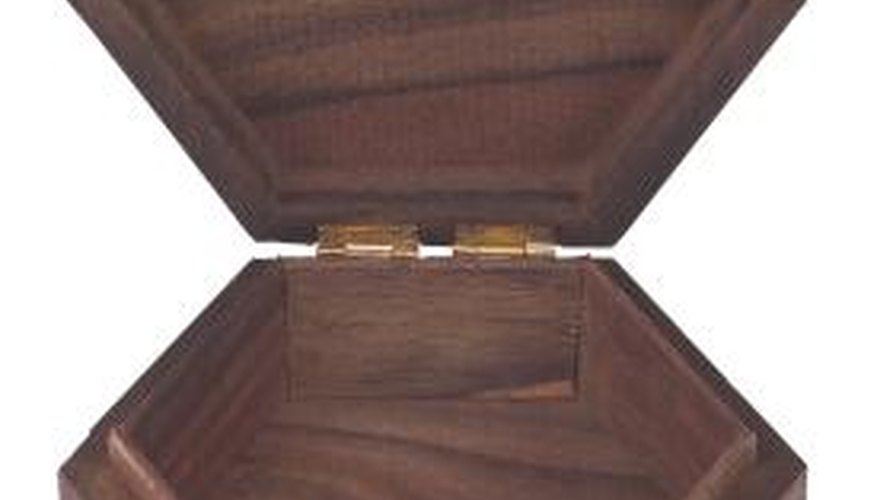A hexagon has six sides and six corresponding angles. Each angle is 120 degrees and the sum of the angles is 720 degrees. A wooden hexagon made from six different pieces of wood will follow this rule. Cutting a 60-degree angle on each end of all six pieces results in six pieces of wood that will fit together and form a hexagon. You may cut the six pieces and angles for a wooden hexagon on a mitre saw using a custom fixture.
Place one edge of the 1-by-4 against the face of the plywood flush with the edge of the plywood and clamp it in place.
- A hexagon has six sides and six corresponding angles.
- Place one edge of the 1-by-4 against the face of the plywood flush with the edge of the plywood and clamp it in place.
Drill four 5/64-inch pilot holes for the wood screws through the plywood bottom and into the 1-by-4 piece. Space the pilot holes three inches apart and one and one-half inches from the ends. Fasten the plywood to the 1-by-4 by screwing the wood screws through the pilot holes and into the 1-by-4.
Remove the clamps from the custom fixture. Place the fixture on the mitre saw table with the 1-by-4 against the fence. Without starting the motor, lower the blade into the table slot and slide the fixture against the blade. Hold the fixture in place and raise the blade.
- Remove the clamps from the custom fixture.
- Without starting the motor, lower the blade into the table slot and slide the fixture against the blade.
Clamp the 1-by-4 on the fixture to the mitre saw fence with clamps. The plywood edge perpendicular to the fence will act as a new fence for cutting complementary angles greater than 45 degrees. For example, to cut a 60-degree angle, set the mitre saw table to 30 degrees with the adjustment handle of the table pointing away from the custom fixture. Place your workpiece on the table against the custom fixture. The angle cut into the workpiece will be 60 degrees.
Remove the custom fixture from the mitre saw. Set the power mitre saw table at 90 degrees. Measure and mark the wood to cut six pieces one-eighth inch longer than the final length required. Place the wood on the mitre saw table and hold it firmly against the fence. Start the saw and lower the blade into and through the wood at the marks to make the cuts.
- Remove the custom fixture from the mitre saw.
- Place the wood on the mitre saw table and hold it firmly against the fence.
Install the custom fixture on the mitre saw table as shown previously. Set the mitre saw table to 30 degrees away from the fixture. Place a hexagon side on mitre saw table with the edge against the fixture fence. Align the blade with the end of the workpiece corner to cut the angle without altering the length of the piece. Clamp the workpiece to the fixture. Start the blade and cut the angle into the wood.
Flip the workpiece end over end so the uncut end is now facing the mitre saw fence. Align the blade to cut the piece as before without altering the length of the piece. Clamp the piece to the fixture. Start the saw and cut the angle onto the end of the wood. Repeat these steps for all six pieces.
- Flip the workpiece end over end so the uncut end is now facing the mitre saw fence.
- Align the blade to cut the piece as before without altering the length of the piece.
Check the length of the pieces for accuracy. You can adjust the length of each by cutting very small amounts off the end of each piece with the saw.
TIP
The mitre saw fixture divides 90-degree angles. If you set the saw to 30 degrees, your workpiece will be cut at 60 degrees while the cut-off piece will be at 30 degrees. When cutting the pieces, align the blade with the corner of the workpiece so that the blade sits over the waste or cut-off piece and the edge of the blade will barely contact the corner. In this fashion, the length of the piece will not be altered.
WARNING
Keep your hands and fingers away from the spinning blade. Wear safety glasses and a dust mask while cutting.
